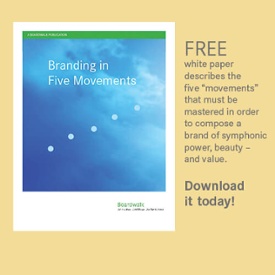 Last week the world’s potentates of commercial and political power, plus a few hangers-on and the press, gathered in an exclusive Swiss hamlet. It’s an annual event officially called the World Economic Forum but it generally goes by the name of its host town, Davos. It’s hard to say if any real work gets done at this thing or if it’s just a glamorous networking opportunity for rich folk. (I imagine these corporate bigwigs and heads of state exchanging business cards and filling their pockets with free hors d’oeuvres to take back to the room.) This year, there’s something of a buzz at Davos. It seems that Larry Fink, head of the investment management firm BlackRock, recently sent a letter to CEOs around the world. The letter warns: Businesses that don’t have a sense of purpose beyond turning a profit will never reach their full potential. He stresses that every company must be positioned to make a positive contribution to society in addition to delivering financial performance. To which many captains of industry have responded, “Yes, but how do we, the world’s wealthiest, most educated class, with all our resources and expertise, figure out how to find purpose?” They should start by considering the lowly hammer.
Last week the world’s potentates of commercial and political power, plus a few hangers-on and the press, gathered in an exclusive Swiss hamlet. It’s an annual event officially called the World Economic Forum but it generally goes by the name of its host town, Davos. It’s hard to say if any real work gets done at this thing or if it’s just a glamorous networking opportunity for rich folk. (I imagine these corporate bigwigs and heads of state exchanging business cards and filling their pockets with free hors d’oeuvres to take back to the room.) This year, there’s something of a buzz at Davos. It seems that Larry Fink, head of the investment management firm BlackRock, recently sent a letter to CEOs around the world. The letter warns: Businesses that don’t have a sense of purpose beyond turning a profit will never reach their full potential. He stresses that every company must be positioned to make a positive contribution to society in addition to delivering financial performance. To which many captains of industry have responded, “Yes, but how do we, the world’s wealthiest, most educated class, with all our resources and expertise, figure out how to find purpose?” They should start by considering the lowly hammer. It’s hard to think of a simpler tool. What is its purpose? When it’s just laying there, inert on the table, it is of no use at all; just a dumb paperweight. Hold on a minute! Could a hammer’s purpose be to keep papers in place when the breeze kicks up? Or is it to drive in a nail? To pull out a nail? To smash a piggy bank? To pound the last pickle into the jar? The point is the hammer does not get to define its own purpose. Its purpose is bestowed upon it by its user. The user intends change of some kind, selects the hammer as the best tool to affect that change, and uses it, accordingly, toward that end purpose. And so it is with companies great and small.
It’s hard to think of a simpler tool. What is its purpose? When it’s just laying there, inert on the table, it is of no use at all; just a dumb paperweight. Hold on a minute! Could a hammer’s purpose be to keep papers in place when the breeze kicks up? Or is it to drive in a nail? To pull out a nail? To smash a piggy bank? To pound the last pickle into the jar? The point is the hammer does not get to define its own purpose. Its purpose is bestowed upon it by its user. The user intends change of some kind, selects the hammer as the best tool to affect that change, and uses it, accordingly, toward that end purpose. And so it is with companies great and small.
The company is the hammer and the user is the market. The companies at Davos are large, publicly held international behemoths so the definition of their markets are correspondingly broad. Markets are made up of constituencies. A constituency is defined as any group whose perception of the company is vital to its future. So that, of course, includes the company’s consumers, those who buy its products or retain its services. It also means shareholders and all their advisors, managers, brokers, etc., people like Larry Fink. Employees, from the mail room to the boardroom, are part of the market because their goodwill is requisite for the success of the company. But the market includes many other constituencies as well: bankers, vendors, competitors, regulatory agencies, the press, just to name some. To be successful, the company has to try to positively influence the perceptions of all these groups. Every business will have a different set of constituencies to make up its market.
So, if we can think of that broad market as the user, and of the company as the tool – what is the market using the company for? What change does the market intend? Put another way: to what purpose is the market using the company? Identify that and you have the company’s true purpose. Purpose is not something dreamed up by management. It is defined by the market.
Granted, it’s not always easy to figure out. When a market is made up of so many wide and varied constituencies, it’s hard to identify any commonalities of intent between them. A company’s customer engages with it for one purpose; the employee of that same company engages for another. Right?
Well, yes but only partially so. Consumers have all sorts of reasons for engaging with brands. And employees need more from their work than just a paycheck. Once you start digging a little, you find all sorts of complicated motivations and psychological forces at work. So, again, how do you sleuth out your purpose to your market? You ask it.
______________________________________________________________________________________________________
Would you like to learn more about
Boardwalk’s approach to Purpose and Positioning?
______________________________________________________________________________________________________
Ideally, companies are in close communication with their markets to begin with. Every market leader knows the importance of this. They are constantly conducting surveys, engaging on social media platforms, hosting events, doing everything they can to learn what their markets need. So many companies will already have some sense of how their market is using them. Nevertheless, it pays to engage in a formal exploration to determine a company’s true purpose. Even if the results confirm what was already suspected, the clarity in so knowing is well worth the exercise. Management can then see with absolute certainty that their market positioning is correct and that their messaging is on target.
A formal exploration will rely heavily on market research and analysis. Every constituency should be canvassed to learn what role the company plays in their lives. A full marketing audit and a survey of the competitive environment should be conducted. Results from each study should be measured against one another to identify common threads, themes or patterns. These correlations will provide the insights that begin to reveal the company’s true purpose. From there, management can deduce the best market positioning for their brand.
And that’s a big benefit from doing this kind of exploration. When you know your true purpose, when you know the reason the market values you and lets you into their lives, you know exactly how to position your company for competitive advantage. This leads to maximal usefulness to your market. And that leads to maximized revenue. Profits are a byproduct of serving the market in the way it wants to be served. And, if somewhere down the road, the market wants to be served in some new way, the company’s purpose must change, like it or not. The market decides. The company must adapt or die.
Larry Fink’s letter to the CEOs at Davos urges their companies make a positive contribution to the world in addition to turning a profit. He’s warning of changes he sees on the horizon. He predicts a future that will demand it of any business. But, in such a world, once a company has clarity and follows through on its true purpose, it will find increased profits ensue because of its positive contribution.
Best Branding Reads – Week of January 29, 2018
How IKEA Founder Kamprad Structured the Brand For Growth
IKEA’s Ingvar Kamprad was a true branding genius. And, as one of the world’s richest men, proof that capitalism is alive and well in that "socialist hell-scape" that is Sweden. Be sure to watch the video.
Super Bowl Commercial Sneak Peek: Cost, Controversy And What To Expect
If there’s a theme to the 2018 Super Bowl ads, it’s –Net Neutrality, fries, and a shake Celebrity Spokesperson.
How Amazon Go Will Drive Brands to Develop New Ways to Target Customers
Amazon paves the way for geo-fencing and other personalized, location-based marketing.
Why All Brands Need A Brain Trust
The author uses Pixar as a case study. Remember: Pixar is the only major studio that has never had a flop. Really interesting read.
Cleveland Indians will remove Chief Wahoo logo from uniforms starting in 2019
You’re next to get with the program, Washington Redskins. Watch how the sky doesn’t fall in Cleveland.
New Logo and Identity for Callen-Lorde
Agree with reviewer: Branding expectations are pretty low in healthcare. So, glad to see someone pushing the envelope. Just can’t decide if this is the way to push.
5 Mandates For Brand Citizenship
Brand Citizenship is an interesting new concept that belongs up there with Beloved Brands, Admired Brands and Brand Intimacy. Good read.



